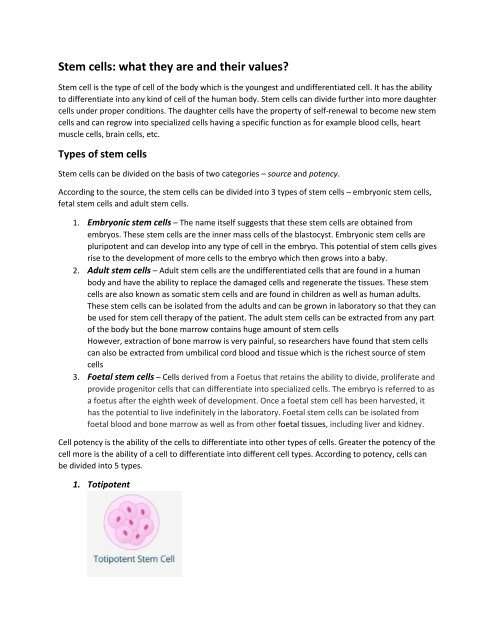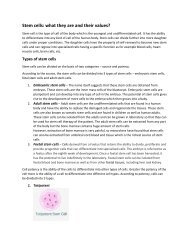Stem cells: what they are and their values?
These stem cells can treat diseases by regenerating themselves into daughter stem cells which further replace the damaged cells of the body to repair the tissues and organs.
These stem cells can treat diseases by regenerating themselves into daughter stem cells which further replace the damaged cells of the body to repair the tissues and organs.
You also want an ePaper? Increase the reach of your titles
YUMPU automatically turns print PDFs into web optimized ePapers that Google loves.
<strong>Stem</strong> <strong>cells</strong>: <strong>what</strong> <strong>they</strong> <strong>are</strong> <strong>and</strong> <strong>their</strong> <strong>values</strong>?<br />
<strong>Stem</strong> cell is the type of cell of the body which is the youngest <strong>and</strong> undifferentiated cell. It has the ability<br />
to differentiate into any kind of cell of the human body. <strong>Stem</strong> <strong>cells</strong> can divide further into more daughter<br />
<strong>cells</strong> under proper conditions. The daughter <strong>cells</strong> have the property of self-renewal to become new stem<br />
<strong>cells</strong> <strong>and</strong> can regrow into specialized <strong>cells</strong> having a specific function as for example blood <strong>cells</strong>, heart<br />
muscle <strong>cells</strong>, brain <strong>cells</strong>, etc.<br />
Types of stem <strong>cells</strong><br />
<strong>Stem</strong> <strong>cells</strong> can be divided on the basis of two categories – source <strong>and</strong> potency.<br />
According to the source, the stem <strong>cells</strong> can be divided into 3 types of stem <strong>cells</strong> – embryonic stem <strong>cells</strong>,<br />
fetal stem <strong>cells</strong> <strong>and</strong> adult stem <strong>cells</strong>.<br />
1. Embryonic stem <strong>cells</strong> – The name itself suggests that these stem <strong>cells</strong> <strong>are</strong> obtained from<br />
embryos. These stem <strong>cells</strong> <strong>are</strong> the inner mass <strong>cells</strong> of the blastocyst. Embryonic stem <strong>cells</strong> <strong>are</strong><br />
pluripotent <strong>and</strong> can develop into any type of cell in the embryo. This potential of stem <strong>cells</strong> gives<br />
rise to the development of more <strong>cells</strong> to the embryo which then grows into a baby.<br />
2. Adult stem <strong>cells</strong> – Adult stem <strong>cells</strong> <strong>are</strong> the undifferentiated <strong>cells</strong> that <strong>are</strong> found in a human<br />
body <strong>and</strong> have the ability to replace the damaged <strong>cells</strong> <strong>and</strong> regenerate the tissues. These stem<br />
<strong>cells</strong> <strong>are</strong> also known as somatic stem <strong>cells</strong> <strong>and</strong> <strong>are</strong> found in children as well as human adults.<br />
These stem <strong>cells</strong> can be isolated from the adults <strong>and</strong> can be grown in laboratory so that <strong>they</strong> can<br />
be used for stem cell therapy of the patient. The adult stem <strong>cells</strong> can be extracted from any part<br />
of the body but the bone marrow contains huge amount of stem <strong>cells</strong><br />
However, extraction of bone marrow is very painful, so researchers have found that stem <strong>cells</strong><br />
can also be extracted from umbilical cord blood <strong>and</strong> tissue which is the richest source of stem<br />
<strong>cells</strong><br />
3. Foetal stem <strong>cells</strong> – Cells derived from a Foetus that retains the ability to divide, proliferate <strong>and</strong><br />
provide progenitor <strong>cells</strong> that can differentiate into specialized <strong>cells</strong>. The embryo is referred to as<br />
a foetus after the eighth week of development. Once a foetal stem cell has been harvested, it<br />
has the potential to live indefinitely in the laboratory. Foetal stem <strong>cells</strong> can be isolated from<br />
foetal blood <strong>and</strong> bone marrow as well as from other foetal tissues, including liver <strong>and</strong> kidney.<br />
Cell potency is the ability of the <strong>cells</strong> to differentiate into other types of <strong>cells</strong>. Greater the potency of the<br />
cell more is the ability of a cell to differentiate into different cell types. According to potency, <strong>cells</strong> can<br />
be divided into 5 types.<br />
1. Totipotent
• Totipotent stem <strong>cells</strong> <strong>are</strong> the most powerful stem cell<br />
• They can differentiate into embryonic <strong>cells</strong> <strong>and</strong> tissues<br />
• Have the ability to develop into a living organism<br />
• e.g. fertilized egg<br />
2. Pluripotent<br />
• These stem <strong>cells</strong> <strong>are</strong> having the ability to renew itself<br />
• They can differentiate into 3 germ layers – ectoderm, endoderm <strong>and</strong> mesoderm<br />
• Also, can develop into any kind of tissues or organs<br />
• e.g. embryonic stem <strong>cells</strong><br />
3. Multipotent<br />
• Multipotent stem <strong>cells</strong> possess the ability of self-renewing<br />
• They can different into a specific kind of cell<br />
• e.g. mesenchymal stem <strong>cells</strong><br />
4. Oligopotent<br />
• Oligopotent stem <strong>cells</strong> have the self-renewing capability<br />
• Restricted to differentiate into closely related cell types<br />
• e.g. hematopoietic stem cell
5. Unipotent<br />
• This stem cell is the least effective<br />
• Have the power to differentiate only into a particular cell type.<br />
• e.g. muscle stem <strong>cells</strong><br />
Benefits of stem <strong>cells</strong><br />
You may be wondering that despite so many other treatments <strong>what</strong> <strong>are</strong> the umbilical cord stem cell<br />
benefits. Overall, the general benefits include minimal risk, minimal recovery time <strong>and</strong> minimum<br />
concern because stem cell therapy uses biological material (cord blood stem <strong>cells</strong>) obtained directly<br />
from the newborn baby. Here <strong>are</strong> five more specific advantages.<br />
• Collection – Collection of cord blood from the umbilical cord is painless <strong>and</strong> risk-free method.<br />
The cord blood is then processed <strong>and</strong> the stem <strong>cells</strong> <strong>are</strong> harvested in the laboratory.<br />
• Outcomes of transplantation – During transplantation of cord blood stem <strong>cells</strong>, there is less<br />
chance of rejection <strong>and</strong> the body of the recipient accepts it easily.<br />
• Differentiative property – As the cord blood stem <strong>cells</strong> <strong>are</strong> young <strong>and</strong> undifferentiated so <strong>they</strong><br />
have the potential to regenerate themselves into any type of <strong>cells</strong> of the body.<br />
• Storage – cord blood stem <strong>cells</strong> can be stored for lifetime in a maintained temperature (-190°C)<br />
<strong>and</strong> in a particular freezer containing liquid nitrogen.<br />
• Infection – When infused into the body of patient cord blood stem <strong>cells</strong> possess less chances of<br />
having any type infection.<br />
“<strong>Stem</strong> <strong>cells</strong> can be extracted from both cord blood <strong>and</strong> cord tissue.”
Cord blood<br />
Cord blood (umbilical cord blood) is blood that remains in the placenta <strong>and</strong> in the attached umbilical<br />
cord after childbirth.<br />
Cord blood is made up of these components - Red blood <strong>cells</strong>, Blood, Plasma, platelets, which <strong>are</strong> found<br />
in the whole blood. In comparison with the whole blood, there <strong>are</strong> some differences in the cord blood,<br />
such as the cord blood contains more natural killer <strong>cells</strong>, lower absolute numbers of the T-<strong>cells</strong> <strong>and</strong> a<br />
higher immature T-<strong>cells</strong> <strong>are</strong> available. However, it is mainly the observation that cord blood contains<br />
various types of stem <strong>and</strong> progenitor <strong>cells</strong>, mostly hematopoietic stem <strong>cells</strong>, that contributes to the<br />
interest of cord blood. Many non-hematopoietic stem cell types <strong>are</strong> also present in cord blood, such as<br />
Mesenchymal stem <strong>cells</strong>, but in a lesser amount than bone marrow. Cord blood can also include<br />
endothelial progenitor <strong>cells</strong> <strong>and</strong> multipotent adult stem <strong>cells</strong>. Cord blood stem <strong>cells</strong> <strong>are</strong> frequently<br />
confused with embryonic stem <strong>cells</strong>. Cord blood stem <strong>cells</strong> <strong>are</strong> the type of adult stem <strong>cells</strong> which is<br />
different from the embryonic stem <strong>cells</strong>.<br />
• Use of cord blood<br />
Cord blood is used the same way that hematopoietic stem cell transplantation is used to<br />
reconstitute bone marrow following radiation treatment for various blood cancers, <strong>and</strong> for<br />
various forms of anaemia. Its efficacy is similar as well.<br />
• Diseases treated by cord blood stem <strong>cells</strong><br />
Cord blood is rich in hematopoietic stem <strong>cells</strong> those <strong>are</strong> pluripotent that means <strong>they</strong> have the<br />
potency to regenerate themselves into any kind of cell of the body. The hematopoietic stem<br />
<strong>cells</strong> can treat diseases related to blood <strong>and</strong> immune system such as leukaemia, anemia, SCIDs,<br />
hypoplasia, etc.
Cord lining<br />
The outermost layer of the umbilical cord is known as cord lining, umbilical cord lining <strong>and</strong> cord tissue.<br />
The umbilical cord itself is an extended part of the placenta <strong>and</strong> is a prolongation of the amniotic<br />
membrane which covers the placenta. The cord tissue membrane is made up of the amniotic layer<br />
which the epithelial layer <strong>and</strong> the sub-amniotic layer which is the epithelial layer. Umbilical cord tissue is<br />
the rich source of two types of stem <strong>cells</strong>, the epithelial stem <strong>cells</strong> <strong>and</strong> the mesenchymal stem <strong>cells</strong>.<br />
• Use of cord lining<br />
Mesenchymal stem <strong>cells</strong> have enormous potential to heal <strong>and</strong> cure different diseases in<br />
damaged tissues <strong>and</strong> organs. EpSC forms the soft tissue that binds, protects <strong>and</strong> covers the<br />
cornea, skin <strong>and</strong> liver of other body structures <strong>and</strong> organs. MSCs <strong>are</strong> the building blocks of bonecartilage,<br />
muscle, fibrous tissues <strong>and</strong> fat tissues in our body.<br />
• Diseases treated by stem <strong>cells</strong> harvested from cord lining<br />
The cord lining also contains stem <strong>cells</strong> as it is the rich source of mesenchymal stem <strong>cells</strong> (MSCs)<br />
<strong>and</strong> epithelial stem <strong>cells</strong> (EpSCs). These mesenchymal stem <strong>cells</strong> can help in treating diseases<br />
such as autism, multiple sclerosis, spinal cord injury <strong>and</strong> epithelial stem <strong>cells</strong> help in treating<br />
diseases related to skin, the cornea of the eye, etc.<br />
Cord blood collection method <strong>and</strong> storage<br />
Once your baby is born <strong>and</strong> separated, the umbilical cord is clamped <strong>and</strong> then the cord blood is<br />
collected in a single-use sterile 250mL blood bag. This cord blood along with cord tissue <strong>and</strong> mother’s<br />
blood sample is then kept in the Kit box which is transported to the storage laboratory by maintaining a<br />
controlled temperature. In the laboratory, the cord blood is processed by an advanced automated<br />
technology known as AXP®II for harvesting hematopoietic stem <strong>cells</strong>. These stem <strong>cells</strong> <strong>are</strong> then stored in<br />
compartmentalized cryopouches at -190°C in liquid nitrogen. This complete method of collection,<br />
processing <strong>and</strong> storage is known as cord blood banking.
Reasons for choosing cord blood stem <strong>cells</strong> for treatment<br />
Children with blood-related disorders such as leukemia <strong>and</strong> inherited blood diseases like Fanconi's<br />
anemia <strong>are</strong> used for the treatment of cord blood. The patient who is suffering from these types of<br />
diseases is first provided with chemotherapy to destroy the damaged <strong>and</strong> diseased <strong>cells</strong> of the body.<br />
Then the young <strong>and</strong> undifferentiated stem <strong>cells</strong> <strong>are</strong> infused into the body of the patient. These stem<br />
<strong>cells</strong> can treat diseases by regenerating themselves into daughter stem <strong>cells</strong> which further replace the<br />
damaged <strong>cells</strong> of the body to repair the tissues <strong>and</strong> organs.<br />
Therefore, cord blood provides a beneficial option for patients when comp<strong>are</strong>d to bone marrow<br />
transplants. The process of collection of cord blood is easier than bone marrow <strong>and</strong> can be stored when<br />
frozen. The risk of immune failure <strong>and</strong> infections, including Graft <strong>and</strong> Host Disease, often seems less<br />
than bone marrow. This means that cord blood does not need to be as perfectly matched to the patient<br />
as bone marrow.<br />
Nevertheless, there <strong>are</strong> also restrictions on cord blood transplants. Cord blood c<strong>are</strong> for adults usually<br />
requires two cord blood units for treatment. Clinical studies using adult dual cord blood transplantation<br />
have shown similar results to other HSC sources, like bone marrow or peripheral blood mobilized. There<br />
<strong>are</strong> currently experiments to extend a single blood cord for adult use.





